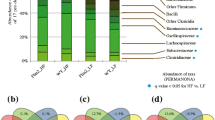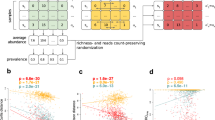Abstract
Diet is known to play a major role in determining the composition and function of the gut microbiota. Previous studies have often focused on the immediate effects of dietary intervention. How dietary history prior to a given dietary intervention influences the gut microbiota is, however, not well understood. To assess the influence of dietary history, in this study, mice with different dietary histories were subjected to the same dietary interventions, and the gut microbial communities of these mice were characterized by 16S rDNA sequencing. We found that dietary history played a long-lasting role in the composition of the gut microbiota when the dietary switch was moderate. In sharp contrast, such effects nearly vanished when the diet was switched to certain extreme dietary conditions. Interestingly, the abundance of Akkermansia, a bacterial genus associated with loss of body weight, was elevated dramatically in mice subjected to a diet composed exclusively of meat. Our results revealed a more complex picture of the influence of dietary history on gut microbiota than anticipated.





Similar content being viewed by others
References
Allison SD, Martiny JB (2008) Colloquium paper: resistance, resilience, and redundancy in microbial communities. Proc Natl Acad Sci USA 105(Suppl 1):11512–11519. https://doi.org/10.1073/pnas.0801925105
Arumugam M, Raes J et al (2011) Enterotypes of the human gut microbiome. Nature 473(7346):174–180. https://doi.org/10.1038/nature09944
Belzer C, de Vos WM (2012) Microbes inside from diversity to function: the case of Akkermansia. ISME J 6(8):1449–1458. https://doi.org/10.1038/ismej.2012.6
Bergström A, Skov TH et al (2014) Establishment of intestinal microbiota during early life: a longitudinal, explorative study of a large cohort of Danish infants. Appl Environ Microbiol 80(9):2889–2900. https://doi.org/10.1128/AEM.00342-14
Bernier JF, Calvert CC, Famula TR, Baldwin RL (1986) Maintenance energy requirement and net energetic efficiency in mice with a major gene for rapid postweaning gain. J Nutr 116(3):419–428. https://doi.org/10.1093/jn/116.3.419
Biasucci G, Benenati B, Morelli L, Bessi E, Boehm G (2008) Cesarean delivery may affect the early biodiversity of intestinal bacteria. J Nutr 138(9):1796S–1800S
Cabrera-Rubio R, Collado MC et al (2012) The human milk microbiome changes over lactation and is shaped by maternal weight and mode of delivery. Am J Clin Nutr 96(3):544–551. https://doi.org/10.3945/ajcn.112.037382
Caporaso JG, Lauber CL et al (2011) Global patterns of 16S rRNA diversity at a depth of millions of sequences per sample. Proc Natl Acad Sci USA 108(Suppl 1):4516–4522. https://doi.org/10.1073/pnas.1000080107
Carmody RN, Gerber GK et al (2015) Diet dominates host genotype in shaping the murine gut microbiota. Cell Host Microbe 17(1):72–84. https://doi.org/10.1016/j.chom.2014.11.010
Chen J, Bittinger K et al (2012) Associating microbiome composition with environmental covariates using generalized UniFrac distances. Bioinformatics 28(16):2106–2113. https://doi.org/10.1093/bioinformatics/bts342
Claesson MJ, Jeffery IB et al (2012) Gut microbiota composition correlates with diet and health in the elderly. Nature 488(7410):178–184. https://doi.org/10.1038/nature11319
Chu DM, Antony KM et al (2016) The early infant gut microbiome varies in association with a maternal high-fat diet. Genome Med 8(1):77. https://doi.org/10.1186/s13073-016-0330-z
Collins KH, Paul HA et al (2016) A high-fat high-sucrose diet rapidly alters muscle integrity, inflammation and gut microbiota in male rats. Sci Rep 6:37278. https://doi.org/10.1038/srep37278
Dao MC, Everard A et al (2016) Akkermansia muciniphila and improved metabolic health during a dietary intervention in obesity: relationship with gut microbiome richness and ecology. Gut 65(3):426–436. https://doi.org/10.1136/gutjnl-2014-308778
David LA, Maurice CF et al (2014) Diet rapidly and reproducibly alters the human gut microbiome. Nature 505(7484):559–563. https://doi.org/10.1038/nature12820
De Filippo C, Cavalieri D et al (2010) Impact of diet in shaping gut microbiota revealed by a comparative study in children from Europe and rural Africa. Proc Natl Acad Sci USA 107(33):14691–14696. https://doi.org/10.1073/pnas.1005963107
Derrien M, Belzer C, de Vos WM (2017) Akkermansia muciniphila and its role in regulating host functions. Microb Pathog 106:171–181. https://doi.org/10.1016/j.micpath.2016.02.005
Derrien M, Collado MC, Ben-Amor K, Salminen S, de Vos WM (2008) The Mucin degrader Akkermansia muciniphila is an abundant resident of the human intestinal tract. Appl Environ Microbiol 74(5):1646–1648. https://doi.org/10.1128/AEM.01226-07
Derrien M, Vaughan EE, Plugge CM, de Vos WM (2004) Akkermansia muciniphila gen. nov., sp. nov., a human intestinal mucin-degrading bacterium. Int J Syst Evol Microbiol 54(Pt 5):1469–1476. https://doi.org/10.1099/ijs.0.02873-0
DeSantis TZ, Hugenholtz P et al (2006) Greengenes, a chimera-checked 16S rRNA gene database and workbench compatible with ARB. Applied Environ Microbiol 72(7):5069–5072. https://doi.org/10.1128/AEM.03006-05
Dominguez-Bello MG, Costello EK et al (2010) Delivery mode shapes the acquisition and structure of the initial microbiota across multiple body habitats in newborns. Proc Natl Acad Sci USA 107(26):11971–11975. https://doi.org/10.1073/pnas.1002601107
Edgar RC (2010) Search and clustering orders of magnitude faster than BLAST. Bioinformatics 26(19):2460–2461. https://doi.org/10.1093/bioinformatics/btq461
Everard A, Belzer C et al (2013) Cross-talk between Akkermansia muciniphila and intestinal epithelium controls diet-induced obesity. Proc Natl Acad Sci USA 110(22):9066–9071. https://doi.org/10.1073/pnas.1219451110
Everard A, Lazarevic V et al (2014) Microbiome of prebiotic-treated mice reveals novel targets involved in host response during obesity. ISME J 8(10):2116–2130. https://doi.org/10.1038/ismej.2014.45
Faith JJ, Guruge JL et al (2013) The long-term stability of the human gut microbiota. Science 341(6141):1237439. https://doi.org/10.1126/science.1237439
Faith JJ, McNulty NP, Rey FE, Gordon JI (2011) Predicting a human gut microbiota’s response to diet in gnotobiotic mice. Science 333(6038):101–104. https://doi.org/10.1126/science.1206025
Gill SR, Pop M et al (2006) Metagenomic analysis of the human distal gut microbiome. Science 312(5778):1355–1359. https://doi.org/10.1126/science.1124234
Girardot C, Scholtalbers J, Sauer S, Su SY, Furlong EE (2016) Je, a versatile suite to handle multiplexed NGS libraries with unique molecular identifiers. BMC Bioinformatics 17(1):419. https://doi.org/10.1186/s12859-016-1284-2
Guo J, Hall KD (2011) Predicting changes of body weight, body fat, energy expenditure and metabolic fuel selection in C57BL/6 mice. PLoS ONE 5(1):e15961. https://doi.org/10.1371/journal.pone.0015961 6) .
Hooper LV, Gordon JI (2001) Commensal host-bacterial relationships in the gut. Science 292(5519):1115–1118
Human Microbiome Project C (2012) Structure, function and diversity of the healthy human microbiome. Nature 486(7402):207–214. https://doi.org/10.1038/nature11234
Karlsson CL, Onnerfalt J et al (2012) The microbiota of the gut in preschool children with normal and excessive body weight. Obesity 20(11):2257–2261. https://doi.org/10.1038/oby.2012.110
Koenig JE, Spor A et al (2011) Succession of microbial consortia in the developing infant gut microbiome. Proc Natl Acad Sci USA 108(Suppl 1):4578–4585. https://doi.org/10.1073/pnas.1000081107
Lim MY, Rho M et al (2014) Stability of gut enterotypes in Korean monozygotic twins and their association with biomarkers and diet. Sci Rep 4:7348. https://doi.org/10.1038/srep07348
Lozupone CA, Stombaugh JI, Gordon JI, Jansson JK, Knight R (2012) Diversity, stability and resilience of the human gut microbiota. Nature 489(7415):220–230. https://doi.org/10.1038/nature11550
Ma J, Prince AL et al (2014) High-fat maternal diet during pregnancy persistently alters the offspring microbiome in a primate model. Nat Commun 5:3889. https://doi.org/10.1038/ncomms4889
McMurdie PJ1, Holmes S (2013) phyloseq: an R package for reproducible interactive analysis and graphics of microbiome census data. PLoS ONE 8(4):e61217. https://doi.org/10.1371/journal.pone.0061217
Muegge BD, Kuczynski J et al (2011) Diet drives convergence in gut microbiome functions across mammalian phylogeny and within humans. Science 332(6032):970–974. https://doi.org/10.1126/science.1198719
Paul HA, Bomhof MR, Vogel HJ, Reimer RA (2016) Diet-induced changes in maternal gut microbiota and metabolomic profiles influence programming of offspring obesity risk in rats. Sci Rep 6:20683. https://doi.org/10.1038/srep20683
Rajilic-Stojanovic M, Heilig HG, Tims S, Zoetendal EG, de Vos WM (2012) Long-term monitoring of the human intestinal microbiota composition. Environ Microbiol. https://doi.org/10.1111/1462-2920.12023
Rutayisire E, Huang K, Liu Y, Tao F (2016) The mode of delivery affects the diversity and colonization pattern of the gut microbiota during the first year of infants’ life: a systematic review. BMC Gastroenterol 16(1):86. https://doi.org/10.1186/s12876-016-0498-0
Schneeberger M, Everard A et al (2015) Akkermansia muciniphila inversely correlates with the onset of inflammation, altered adipose tissue metabolism and metabolic disorders during obesity in mice. Sci Rep 5:16643. https://doi.org/10.1038/srep16643
Shin NR, Lee JC et al (2014) An increase in the Akkermansia spp. population induced by metformin treatment improves glucose homeostasis in diet-induced obese mice. Gut 63(5):727–735. https://doi.org/10.1136/gutjnl-2012-303839
Sonnenburg ED, Smits SA et al (2016) Diet-induced extinctions in the gut microbiota compound over generations. Nature 529(7585):212–215. https://doi.org/10.1038/nature16504
Swiatecka D, Narbad A, Ridgway KP, Kostyra H (2011) The study on the impact of glycated pea proteins on human intestinal bacteria. Int J Food Microbiol 145(1):267–272. https://doi.org/10.1016/j.ijfoodmicro.2011.01.002
Turnbaugh PJ, Hamady M et al (2009) A core gut microbiome in obese and lean twins. Nature 457(7228):480–484. https://doi.org/10.1038/nature07540
Turnbaugh PJ, Ley RE et al (2006) An obesity-associated gut microbiome with increased capacity for energy harvest. Nature 444(7122):1027–1031. https://doi.org/10.1038/nature05414
Wang Q, Garrity GM, Tiedje JM, Cole JR (2007) Naive Bayesian classifier for rapid assignment of rRNA sequences into the new bacterial taxonomy. Appl Environ Microbiol 73(16):5261–5267. https://doi.org/10.1128/AEM.00062-07
Wang Y, Xu L, Liu J, Zhu W, Mao S (2017) A high grain diet dynamically shifted the composition of mucosa-associated microbiota and induced mucosal injuries in the colon of sheep. Front Microbiol. https://doi.org/10.3389/fmicb.2017.02080
Wu GD, Chen J et al (2011) Linking long-term dietary patterns with gut microbial enterotypes. Science 334(6052):105–108. https://doi.org/10.1126/science.1208344
Zhang C, Zhang M et al (2012) Structural resilience of the gut microbiota in adult mice under high-fat dietary perturbations. ISME J 6(10):1848–1857. https://doi.org/10.1038/ismej.2012.27
Acknowledgements
We are grateful to members of the He lab for their discussion and comments on this manuscript. This work is supported by the Natural Science Foundation of Guangdong Province, China (Project No. 2017A030313121).
Author information
Authors and Affiliations
Corresponding author
Ethics declarations
Conflict of interest
The authors declare no conflict of interest.
Additional information
Publisher’s Note
Springer Nature remains neutral with regard to jurisdictional claims in published maps and institutional affiliations.
Electronic supplementary material
Below is the link to the electronic supplementary material.
Rights and permissions
About this article
Cite this article
Yang, B., Ye, C., Yan, B. et al. Assessing the Influence of Dietary History on Gut Microbiota. Curr Microbiol 76, 237–247 (2019). https://doi.org/10.1007/s00284-018-1616-8
Received:
Accepted:
Published:
Issue Date:
DOI: https://doi.org/10.1007/s00284-018-1616-8




